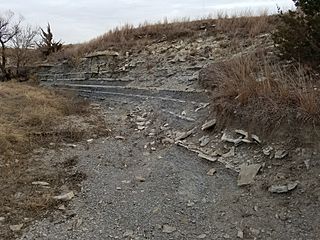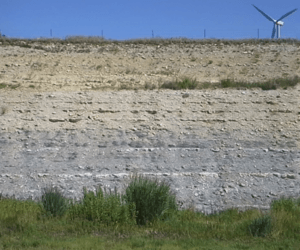Greenhorn Limestone facts for kids
Quick facts for kids Greenhorn LimestoneStratigraphic range: Cenomanian-Turonian, around 94.3–89.3Ma |
|
|---|---|

The Jetmore Chalk Member of the Greenhorn Formation in Kansas.
|
|
| Type | Formation |
| Unit of | Colorado Group (lower), Benton Formation/Group, or Cody Shale |
| Sub-units | Colorado members: Bridge Creek Limestone Hartland Shale Lincoln Limestone Kansas members: Pfeifer Shale (with Fencepost ls) Jetmore Chalk Hartland Shale Lincoln Limestone |
| Underlies | Carlile Shale |
| Overlies | Graneros Shale |
| Lithology | |
| Primary | Shale to chalky shale Limestone, chalk to marl |
| Other | bentonite |
| Location | |
| Coordinates | 38°16′37″N 104°42′47″W / 38.277°N 104.713°W |
| Region | mid-continental |
| Country | United States |
| Type section | |
| Named for | Greenhorn Station, 14 mi south of Pueblo, CO, and for Greenhorn Creek |
| Named by | Grove Karl Gilbert |
| Year defined | 1896 |
The Greenhorn Limestone or Greenhorn Formation is a special type of rock layer. It is found in the Great Plains Region of the United States. This rock layer formed during the Cenomanian and Turonian ages, which were part of the Late Cretaceous period. That was about 94 to 89 million years ago!
Contents
What is the Greenhorn Formation?

The Greenhorn Formation was named in 1896 by a scientist named Grove Karl Gilbert. He named it after Greenhorn Station and Greenhorn Creek in Colorado.
This rock layer is important because it tells us about a time when a huge sea covered much of central North America. This ancient sea is called the Cretaceous Western Interior Seaway. The Greenhorn Formation shows us when this sea was getting deeper. Other rock layers above it show when the sea started to get shallower again.
You can find the Greenhorn Formation across a large area. It stretches from Minnesota and Iowa all the way to New Mexico and up to Montana and the Dakotas. In parts of Canada, similar rock layers are also found.
Layers within the Greenhorn
In some places, like Kansas, the Greenhorn Formation is divided into smaller layers. These layers are called members. From bottom to top, they are the Lincoln Limestone, Hartland Shale, Jetmore Chalk, and Pfeifer Shale. Each of these layers looks a little different, especially in how chalky they are.
In Colorado and western Kansas, the layers are slightly different. They are called the Lincoln Limestone, Hartford Shale, and Bridge Creek Limestone. In other states, the Greenhorn Formation might not be divided into these smaller parts.
Kansas State Rock
The Greenhorn Formation is very famous in Kansas. Its top layer is called the Fencepost limestone. This tough limestone was used to cut stone posts for fences across the state. These "post rocks" are so important that in 2018, the Greenhorn Limestone was named the official state rock of Kansas!
The strong Fencepost limestone, along with the softer chalk and shale layers around it, helped create the Smoky Hills in Kansas.
What does the Greenhorn Formation look like?

The Greenhorn Formation is mostly made of shale and chalky shale. It usually looks light bluish-gray. You can see repeating layers of chalk or limestone within it. These layers are called rhythmites because they repeat in a pattern. Closer to the Rocky Mountains, the rock layers become more like marl, which is a mix of clay and limestone. When the shale is exposed to air, it can turn a buff (light yellowish-brown) color.
You might also see thin, rust-colored layers of bentonite. Bentonite is a type of clay that forms from volcanic ash. These bentonite layers are like special markers that help scientists identify different parts of the formation. The orange and yellow stains you see on some of the rocks are from volcanic events that happened long ago. Iron and sulfur from the volcanoes mixed with the mud, creating minerals that later changed and caused these colorful stains.
What fossils are found here?
The Greenhorn Formation is well-known for its index fossils. These are special fossils that help scientists figure out the age of the rocks. Some of the fossils found here include types of oysters called Ostrea, spiral-shelled creatures called ammonites, and squid-like animals called Belemnitida. Large clams called Inoceramidae are also common.
Scientists have even found dinosaur remains in this formation!
Images for kids
-
Large marine predators of the late Cretaceous; Pliosauroidea and Xiphactinus. Also, huge oyster-encrusted clams.


